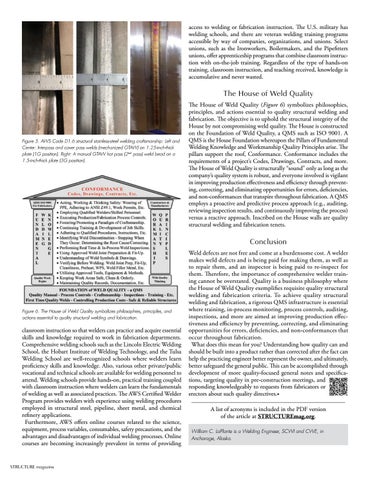access to welding or fabrication instruction. The U.S. military has welding schools, and there are veteran welding training programs accessible by way of companies, organizations, and unions. Select unions, such as the Ironworkers, Boilermakers, and the Pipefitters unions, offer apprenticeship programs that combine classroom instruction with on-the-job training. Regardless of the type of hands-on training, classroom instruction, and teaching received, knowledge is accumulative and never wasted.
The House of Weld Quality
Figure 5. AWS Code D1.6 structural stainless-steel welding craftsmanship: Left and Center: Interpass and cover pass welds (mechanized GTAW) on 1.25-inch-thick plate (1G position). Right: A manual GTAW hot pass (2n d pass) weld bead on a 1.5-inch-thick plate (3G position).
The House of Weld Quality (Figure 6) symbolizes philosophies, principles, and actions essential to quality structural welding and fabrication. The objective is to uphold the structural integrity of the House by not compromising weld quality. The House is constructed on the Foundation of Weld Quality, a QMS such as ISO 9001. A QMS is the House Foundation whereupon the Pillars of Fundamental Welding Knowledge and Workmanship Quality Principles arise. The pillars support the roof, Conformance. Conformance includes the requirements of a project’s Codes, Drawings, Contracts, and more. The House of Weld Quality is structurally “sound” only as long as the company’s quality system is robust, and everyone involved is vigilant in improving production effectiveness and efficiency through preventing, correcting, and eliminating opportunities for errors, deficiencies, and non-conformances that transpire throughout fabrication. A QMS employs a proactive and predictive process approach (e.g., auditing, reviewing inspection results, and continuously improving the process) versus a reactive approach. Inscribed on the House walls are quality structural welding and fabrication tenets.
Conclusion
Figure 6. The House of Weld Quality symbolizes philosophies, principles, and actions essential to quality structural welding and fabrication.
classroom instruction so that welders can practice and acquire essential skills and knowledge required to work in fabrication departments. Comprehensive welding schools such as the Lincoln Electric Welding School, the Hobart Institute of Welding Technology, and the Tulsa Welding School are well-recognized schools where welders learn proficiency skills and knowledge. Also, various other private/public vocational and technical schools are available for welding personnel to attend. Welding schools provide hands-on, practical training coupled with classroom instruction where welders can learn the fundamentals of welding as well as associated practices. The AWS Certified Welder Program provides welders with experience using welding procedures employed in structural steel, pipeline, sheet metal, and chemical refinery applications. Furthermore, AWS offers online courses related to the science, equipment, process variables, consumables, safety precautions, and the advantages and disadvantages of individual welding processes. Online courses are becoming increasingly prevalent in terms of providing
STRUCTURE magazine
Weld defects are not free and come at a burdensome cost. A welder makes weld defects and is being paid for making them, as well as to repair them, and an inspector is being paid to re-inspect for them. Therefore, the importance of comprehensive welder training cannot be overstated. Quality is a business philosophy where the House of Weld Quality exemplifies requisite quality structural welding and fabrication criteria. To achieve quality structural welding and fabrication, a rigorous QMS infrastructure is essential where training, in-process monitoring, process controls, auditing, inspections, and more are aimed at improving production effectiveness and efficiency by preventing, correcting, and eliminating opportunities for errors, deficiencies, and non-conformances that occur throughout fabrication. What does this mean for you? Understanding how quality can and should be built into a product rather than corrected after the fact can help the practicing engineer better represent the owner, and ultimately, better safeguard the general public. This can be accomplished through development of more quality-focused general notes and specifications, targeting quality in pre-construction meetings, and responding knowledgeably to requests from fabricators or erectors about such quality directives.■ A list of acronyms is included in the PDF version of the article at STRUCTUREmag.org. William C. LaPlante is a Welding Engineer, SCWI and CWE, in Anchorage, Alaska.
